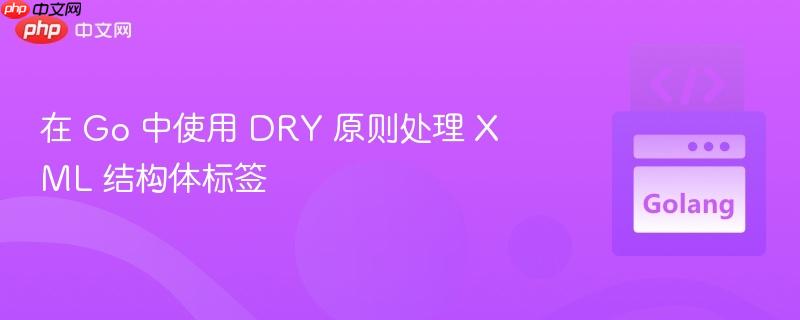
在 Go 语言中解析 XML 数据时,经常会遇到需要在多个结构体中定义相同字段和 XML 标签的情况,例如,每个结构体都包含一个 Description 字段,并使用相同的 xml:"description,omitempty" 标签。为了避免重复定义,可以使用嵌入带有结构体标签的公共结构体的方式,实现代码的 DRY (Don't Repeat Yourself) 原则。
我们可以创建一个包含公共字段和标签的结构体,然后将其嵌入到其他结构体中。例如,创建一个名为 describable 的结构体,其中包含 Description 字段和 xml:"description" 标签:
type describable struct{
Description string `xml:"description"`
}然后,可以将 describable 结构体嵌入到其他结构体中,例如 subobjA 和 subobjB:
type subobjA struct {
describable
XMLName xml.Name `xml:"subobjA"`
}
type subobjB struct {
describable
XMLName xml.Name `xml:"subobjB"`
}
type obj struct {
XMLName xml.Name `xml:"obj"`
A subobjA
B subobjB
}通过这种方式,subobjA 和 subobjB 结构体都继承了 Description 字段和 xml:"description" 标签,避免了重复定义。
需要注意的是,嵌入结构体中的字段会被提升到外部结构体,可以直接通过外部结构体访问。例如,可以通过 sampleObj.Description 访问 sampleObj.describable.Description。
Go 语言规范中对字段提升的定义如下:
A field or method f of an anonymous field in a struct x is called promoted if x.f is a legal selector that denotes that field or method f.Promoted fields act like ordinary fields of a struct except that they cannot be used as field names in composite literals of the struct.
这意味着,嵌入结构体中的字段可以像普通字段一样使用,但不能在结构体字面量中使用。
以下是一个完整的示例代码,演示了如何使用嵌入结构体来解析 XML 数据:
package main
import (
"encoding/xml"
"fmt"
)
type describable struct {
Description string `xml:"description"`
}
type subobjA struct {
describable
XMLName xml.Name `xml:"subobjA"`
Foo string `xml:"foo"`
}
type subobjB struct {
describable
XMLName xml.Name `xml:"subobjB"`
Bar string `xml:"bar"`
}
type obj struct {
XMLName xml.Name `xml:"obj"`
A subobjA `xml:"subobjA"`
B subobjB `xml:"subobjB"`
}
func main() {
sampleXml := `
<obj>
<description>outer object</description>
<subobjA>
<description>first kind of subobject</description>
<foo>some goop</foo>
</subobjA>
<subobjB>
<description>second kind of subobject</description>
<bar>some other goop</bar>
</subobjB>
</obj>
`
sampleObj := obj{}
err := xml.Unmarshal([]byte(sampleXml), &sampleObj)
if err != nil {
fmt.Println("Error unmarshalling XML:", err)
return
}
fmt.Println(sampleObj.Description)
fmt.Println(sampleObj.A.Description)
fmt.Println(sampleObj.B.Description)
fmt.Println(sampleObj.A.Foo)
fmt.Println(sampleObj.B.Bar)
}在这个示例中,obj 结构体包含 subobjA 和 subobjB 结构体,而这两个结构体又都嵌入了 describable 结构体。通过这种方式,我们可以避免重复定义 Description 字段和 xml:"description" 标签。
通过嵌入带有结构体标签的公共结构体,可以有效地避免在多个结构体中重复定义相同的字段和标签,提高代码的可维护性和可读性。同时,Go 语言的字段提升机制也简化了对嵌入结构体字段的访问,使得代码更加简洁。在处理 XML 数据时,可以考虑使用这种方式来组织结构体,实现代码的 DRY 原则。
以上就是在 Go 中使用 DRY 原则处理 XML 结构体标签的详细内容,更多请关注php中文网其它相关文章!

每个人都需要一台速度更快、更稳定的 PC。随着时间的推移,垃圾文件、旧注册表数据和不必要的后台进程会占用资源并降低性能。幸运的是,许多工具可以让 Windows 保持平稳运行。

Copyright 2014-2025 https://www.php.cn/ All Rights Reserved | php.cn | 湘ICP备2023035733号